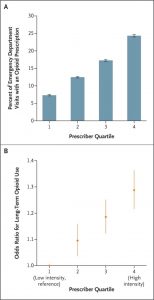If an opioid prescription is given for acute non-cancer pain, the shortest duration and the lowest milligram morphine equivalent MMEs (by total dose and pill count) dose that is deemed effective to manage the condition should be used. Per latest CDC guidelines (2016), 3 days of opioid therapy is often sufficient and >7 days is rarely needed for acute pain.
In a recent study of almost 400,000 patients (Barnett ML et al, NEJM 2017), ED physicians were categorized as being high–intensity or low–intensity opioid prescribers according to relative quartiles of prescribing rates within their hospital. Long–term opioid use was defined as ≥180 days of opioids supplied in the 12 months after the index ED visit, excluding prescriptions within 30 days after the index visit. Rates of long-term opioid use were compared in patients treated by high or low-intensity prescribers. Overall, patient characteristics and diagnoses treated were similar across all prescribers. There was >3-fold increase in opioid prescription rates by the high-intensity prescribers as compared to low-intensity (24.1% vs. 7.3% of ED visits, see figure below). Patients treated by high-intensity opioid prescribers had a 30% increased risk of long–term opioid use.
A similar study (Deyo RA et al, JGIM 2017) evaluating 500,000 opioid–naïve patients demonstrated that both the number of prescriptions in the 1st month of opioid consumption and total morphine milligram equivalents (MMEs) prescribed were highly correlated with risk of long–term use, defined as ≥6 opioid prescriptions in the subsequent 12 months. After excluding patients with cancer pain and non-cancer chronic pain conditions, compared to the group that only filled 1 prescription in the first month, those who filled ≥2 were 4 to 10 times as likely to become long–term users. Additionally, those who were dispensed >120 morphine milligram equivalents total (MME; e.g. 120 MME = oxycodone 5mg PO q6h PRN x 4 days) were 2-16 times as likely to be long–term opioid users, with increasing MME dispensed associated with increased risk.
References:
- Barnett ML, Olenski AR, Jena AB. Opioid-Prescribing Patterns of Emergency Physicians and Risk of Long-Term Use. NEJM 2017; 376:663-673.
- Deyo RA, Hallvik SE, Hildebran C, et al. Association Between Initial Opioid Prescribing Patterns and Subsequent Long-Term Use Among Opioid-Naïve Patients: A Statewide Retrospective Cohort Study. J Gen Intern Med. 2017; 32:21-27.
- Dowell D, Haegerich TM, Chou R. CDC guideline for prescribing opioids for chronic pain – United States, 2016. JAMA. 2016; 315:1624–45.
- Cooper TE, Chen J, Wiffen PJ, et al. Morphine for chronic neuropathic pain in adults. Cochrane Database Syst Rev. 2017 May 22;5:CD011669.

